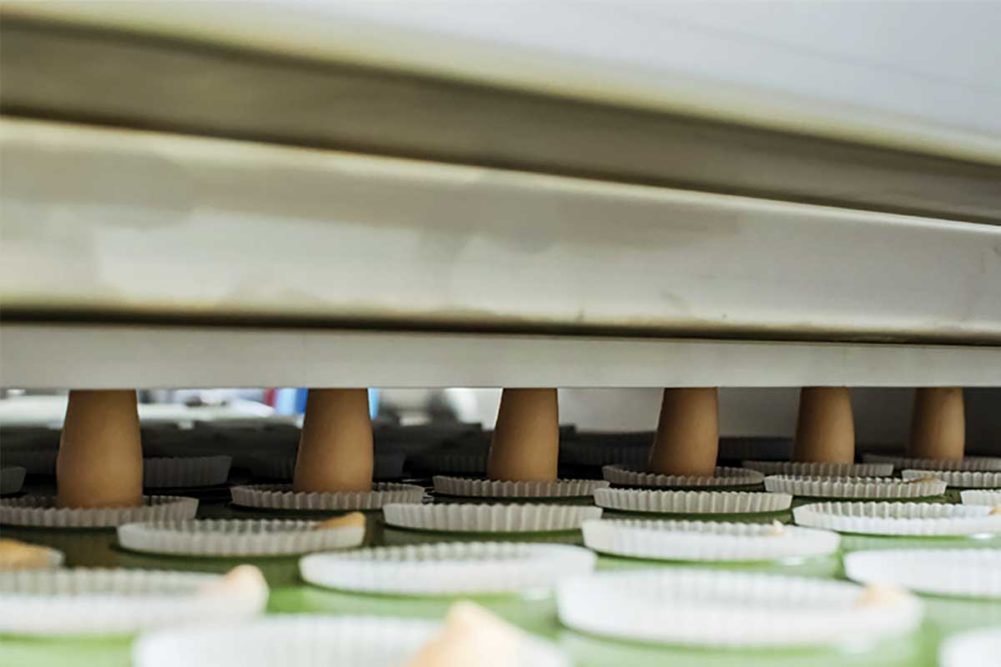Consumers are a fickle lot. They want healthy and nutritious foods, but they love decadent treats as well. And over the past couple of years, consumers have been leaning toward indulgent treats. For many, that means cake, which comes in many delicious formats: sheet cakes, cheesecakes, cupcakes, muffins and snack cakes, some that are fully loaded and others with reduced sugar or fat.
Bakers are interested in giving the people what they want, so that means finding the best ways to keep cake processing lines chugging along while grappling with workforce issues. A smooth cake operation is all about high-quality ingredients going into machinery kept in top working condition that carefully handles the batters.
“Start with a good product,” said Jamie Bobyk, marketing manager, Apex Motion Control. “Generally speaking, what goes into the hopper is what comes out of the nozzle. You want to choose equipment that is gentle on the product; the more the product is handled, the fewer chances you have of maintaining a nicely aerated product, whether it be batters or whipped products such as whipped creams.”
Cake batters must be deposited into pans cleanly, accurately and without de-aerating the batters. Successfully translating recipes into formulations made on production lines that will make thousands of cakes consistently is challenging.
“Our food technologists are key to getting a mess of pumps and switches and valves and tanks to produce what we do by hand in the kitchen,” said Benjamin Jewell, sales manager, US Midwest, Bühler. “Oftentimes we start by saying, ‘Show me how you do it by hand?’ Then we commercially try to perfect that with the balance of our engineers who know engineering and our food technologists who know food and food science.”
Oakes’ custom recipe-based PLC mixer controller simplifies operator input, said Bob Peck, vice president in charge of engineering, E.T. Oakes Corp.
“Our low-pressure depositing system is designed to protect batter density,” he said. “In other words, aerated batter flows gently to the manifold, in closed piping, directly from the continuous mixer or holding tank and is gently deposited into pans.”
Axis Automation has incorporated specially designed lobed pump rotors that gently and continuously feed product, preserving aeration, said Ty Sarajian, company president.
“This innovation ensures that bakers can seamlessly transition from specialized mixers while maintaining superior quality in their baked goods,” he said.
Clean label and specialty cakes, such as gluten-free and vegan, can pose challenges as the batters can be more viscous and lack certain additives that help with machinability and more.
“When it comes to clean label batters, we understand the challenges bakers face,” Sarajian said. “These batters often lack the additives that aid in structure and aeration. To overcome this, our technology’s precise temperature control and pressure monitoring capabilities help maintain aeration levels even in the absence of certain additives. This ensures that bakers can achieve the desired texture and quality while adhering to clean label requirements.”
He added that the lobed pump rotors prevent overmixing and compaction, which reduce aeration in gluten-free and vegan cakes.
Many clean label batters are not homogenous, which can cause uneven weights, said Hans Besems, executive product manager, AMF Tromp, an AMF Bakery Systems brand.
“It’s critical to focus on the mixing process of these batters to ensure even weights of batter are sent to the depositing line,” he said. “Vegan is most challenging without egg as an emulsifier to ensure consistent batter; without egg, separation can start, so bakers must find something else in the recipe to replace it. In looking at trends in vegan cake production, we’re not fully automating processes yet but working with various ingredient suppliers to look for new vegan-style recipes that can be automated.”
Keeping the batters intact is all about choosing the right pumps and pressures so that the structure is not disturbed when depositing, so recipes must be correctly set up in the machinery, Jewell said.
Bakers must work from what the aeration levels need to be post-depositor, said Pim Bos, product manager, mixing and aeration systems, Bühler.
“From there, we need to anticipate what the consequence is from the mechanical action of the depositor and bear this in mind for the settings of the equipment,” he said. “The position of equipment is also relevant here; pumping the mass through piping also has an effect on the level of aeration and/or temperature.”
Peck said specialty cake batters haven’t had much of an effect on Oakes’ equipment, although some adjustments have been made.
“We have noticed the need to increase the horsepower on some equipment to compensate for the reduction in flowability and the increased viscosity of some of these products,” he said.
Unifiller Systems offer bakers the option of adding a stirrer/mixer to the hopper of a depositor to ensure proper aeration, said Sonia Bal, director of marketing. And equipment can help maintain the proper aeration with frosting application as well.
“Our newest production launch, the Sheetcake Icing System, which top and side ices sheet cakes for cake manufacturers supplying supermarkets and grocery stores, can really help in reducing air bubbles and ensuring smooth buttercream application to the cakes,” she added.
This article is an excerpt from the December 2023 issue of Baking & Snack. To read the entire feature on Cake Processing, click here.






